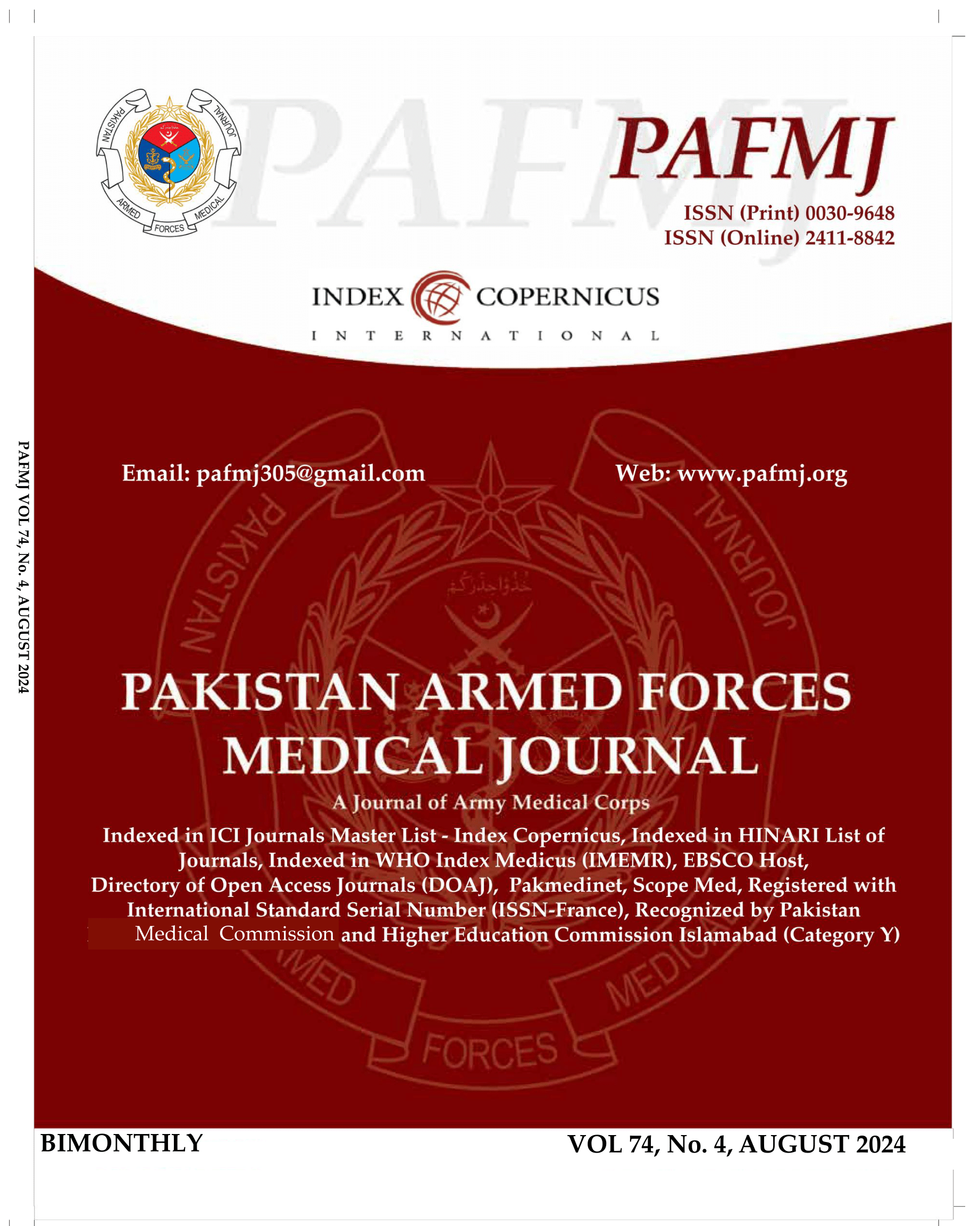Specific Aphasia Screener in Urdu (SAS-U): Its Development and Reliability
DOI:
https://doi.org/10.51253/pafmj.v74i4.4128Keywords:
Aphasia, Language disorder, Specific aphasia screener, Urdu.Abstract
Objective: To develop specific aphasia screener for adults in Urdu language.
Study Design: Comparative cross Sectional study.
Place and Duration of Study: Speech therapy clinic of National Institute of Rehabilitation Sciences, Islamabad Pakistan, from Nov 2016 to Apr 2017.
Methodology: A specific aphasia screener in Urdu was developed by an expert committee, relevant to local clinical and cultural setting, pilot tested, revised and used in main. Sample size was attained using consecutive sampling technique. Sample included 50 aphasic adults aged 40-70 of both genders, divided into 25 being allocated in Control Group and 25 in experimental group. Experimental group was subjected to the Urdu screener, while Control Group subjected to informal assessment.
Results: There was no significant difference in age and gender statistics between control and experimental group with p=0.765 and p=0.245 respectively, there was statistically significant difference in time of application between the two groups (p<0.001) assessment time of 36-40 minutes in majority and no assessment completed before 25 minutes while in the experimental group, majority of assessments were completed in 15-20- and 21-25-minutes group. Cronbach alpha value of 0.747 of Specific Aphasia Screener proved its internal consistency.
Conclusion: Specific Aphasia Screener in Urdu is simple, precise, reliable and applicable in short time to assess the language competence of patients with aphasia.
Downloads
References
Code C. Aphasia. In: The Cambridge Handbook of Psychology, Health and Medicine. 2019; p.317-336.
https://doi.org/10.1017/9781316783269
Azhar A, Maqbool S, Butt GA, Iftikhar S, Iftikhar G. Frequency of aphasia and its symptoms in stroke patients. J Speech Pathol Ther 2017; 2(1): 1-3. https://doi.org/10.4172/2472-5005.1000121
Ismail M, Mumtaz N, Babur MN, Saqulain G. Quality of life in post-stroke aphasia patients. Isra Med J 2019; 11(4):314-317
. Clark DG, Mendez MF, Wilterdink JL. Approach to the patient with aphasia. In: UpToDate, Post TW (Ed), UpToDate, Waltham, MA. Internet. Available at:
https://www.uptodate.com/contents/approach-to-the-patient-with-aphasia (Accessed on April 9, 2022)
Fridriksson J, den Ouden DB, Hillis AE, Hickok G, Rorden C, Basilakos A, et al. Anatomy of aphasia revisited. Brain 2018; 141(3): 848-862. https://doi.org/10.1093/brain/awx363
Murray L, Coppens P. Formal and informal assessment of aphasia. Papathanasiou I, Coppens P, editors. In: Aphasia and Related Neurogenic Communication Disorders. 2nd Edition. Burlington, MA: Jones & Bartlett Learning. 2017. p. 81-105.
Rohde A, Worrall L, Godecke E, O’Halloran R, Farrell A, Massey M. Diagnosis of aphasia in stroke populations: a systematic review of language tests. PLoS One 2018; 13(3): 1-17.
https://doi.org/10.1371/journal.pone.0194143
Guo YE, Togher L, Power E. Speech pathology services for people with aphasia: what is the current practice in Singapore? Disabil Rehabil 2014; 36(8): 691-704.
https://doi.org/10.3109/09638288.2013.804597
Sabe L, Courtis MJ, Saavedra MM, Prodan V, de Luján-Calcagno M, Melián S. [Development and validation of a short battery of tests for the assessment of aphasia: 'bedside assessment of language'. Its use in a rehabilitation centre]. Rev Neurol 200816-30; 46(8): 454-460.
Sample Size Calculator: One Proportion Cross-Sectional. Internet. Available at:
http://www2.ccrb.cuhk.edu.hk/stat/epistudies/x1.htm#2 (Accessed on September 4, 2022.)
Yi X, Luo H, Zhou J, Yu M, Chen X, Tan L, et al. Prevalence of stroke and stroke-related risk factors: a population-based cross-sectional survey in southwestern China. BMC Neurol 2020; 20(1): 5. https://doi.org/10.1186/s12883-019-1592-z
Nakase-Thompson R, Manning E, Sherer M, Yablon SA, Gontkovsky SL, Vickery C. Brief assessment of severe language impairments: initial validation of the Mississippi aphasia screening test. Brain Inj 2005; 19(9): 685-691.
https://doi.org/10.1080/02699050400025266
Flamand-Roze C, Falissard B, Roze E, Maintigneux L, Beziz J, Chacon A, et al. Validation of a new language screening tool for patients with acute stroke. Stroke 2011; 42(5):1224-1229. https://doi.org/10.1161/STROKEAHA.110.609503
Azuar C, Leger A, Arbizu C, Henry-Amar F, Chomel-Guillaume S, Samson Y. The Aphasia Rapid Test: an NIHSS-like aphasia test. J Neurol 2013; 260(8): 2110-2117.
https://doi.org/10.1007/s00415-013-6943-x
El Hachioui H, Visch-Brink EG, de Lau LM, van de Sandt-Koenderman MW, Nouwens F, Koudstaal PJ, et al. Screening tests for aphasia in patients with stroke: a systematic review. J Neurol 2017; 264(2): 211-220.
https://doi.org/10.1007/s00415-016-8170-8
Salter K, Jutai J, Foley N, Hellings C, Teasell R. Identification of aphasia post-stroke: a review of screening assessment tools. Brain Inj 2006; 20(6): 559-568.
https://doi.org/10.1080/02699050600744082
El Hachioui H, Visch-Brink EG, de Lau LM, van de Sandt-Koenderman MW, Nouwens F, Koudstaal PJ, et al. Screening tests for aphasia in patients with stroke: a systematic review. J Neurol 2017; 264(2): 211-220.
https://doi.org/10.1007/s00415-016-8170-8
Macoir J, Fossard M, Lefebvre L, Monetta L, Renard A, Tran TM, et al. Detection Test for Language Impairments in Adults and the Aged—A New Screening Test for Language Impairment Associated With Neurodegenerative Diseases: Validation and Normative Data. Am J Alzheimers Dis Other Demen 2017; 32(7): 382-392.
https://doi.org/10.1177/1533317517715905
Nitsch KP, Casaletto KB, Carlozzi NE, Tulsky DS, Heinemann AW, Heaton RK. Uncorrected versus demographically corrected scores on the NIH Toolbox Cognition Battery in persons with traumatic brain injury and stroke. Rehabil Psychol 2017; 62(4): 485-495.
https://doi.org/10.1037/rep0000122
Salehi S, Jahan AS, Mousavi N, Hashemilar M, Razaghi Z, Moghadam-Salimi M. Developing Azeri aphasia screening test and preliminary validity and reliability. Iran J Neurol 2016; 15(4): 183-188.
Xiangyang Z. Language as a reflection of culture: on the cultural characteristics of Chinese and English proverbs. Intercult Commun Stud 2016; (3): 275-291.
Downloads
Published
Issue
Section
License
Copyright (c) 2024 Tehmina Yousaf, Sadaf Noveen, Ghulam Saqulain, Anees Fatima, Shiza Munsoor

This work is licensed under a Creative Commons Attribution-NonCommercial 4.0 International License.















